The Mobile WLAN Access Points Market is estimated to be valued at USD 5.8 billion in 2025 and is projected to reach USD 15.4 billion by 2035, registering a compound annual growth rate (CAGR) of 10.2% over the forecast period.
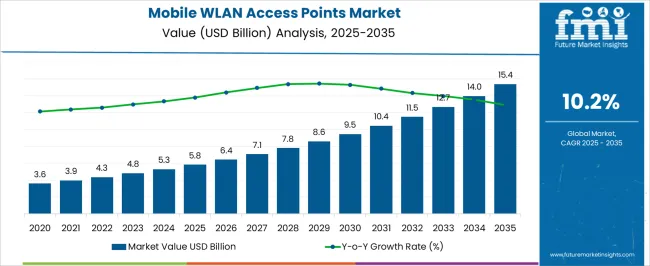
| Metric | Value |
|---|---|
| Mobile WLAN Access Points Market Estimated Value in (2025 E) | USD 5.8 billion |
| Mobile WLAN Access Points Market Forecast Value in (2035 F) | USD 15.4 billion |
| Forecast CAGR (2025 to 2035) | 10.2% |
The mobile WLAN access points market is demonstrating significant growth, supported by the rising demand for seamless wireless connectivity across enterprise, commercial, and residential environments. Expanding data traffic volumes, increasing penetration of smart devices, and the growing reliance on high-bandwidth applications are creating strong opportunities for WLAN solutions. Technological advancements in Wi-Fi standards, particularly the shift toward faster, more reliable protocols, are reshaping deployment strategies.
Investments in 5G integration and edge computing are further reinforcing the importance of WLAN access points, enabling flexible connectivity solutions for mobile and fixed applications. Indoor and outdoor deployments are being prioritized across industries such as education, healthcare, and manufacturing, where uninterrupted coverage is essential. As organizations adopt digital transformation initiatives, the need for scalable, secure, and high-capacity wireless infrastructure is becoming critical.
Supportive regulatory frameworks, alongside investments in smart city projects and enterprise-grade communication systems, are also contributing to demand With performance, security, and mobility driving purchasing decisions, the mobile WLAN access points market is expected to maintain strong growth momentum in the coming years.
The mobile wlan access points market is segmented by standard, location, and geographic regions. By standard, mobile wlan access points market is divided into IEEE 802.11N, IEEE 802.11 A/B/G, IEEE 802.11 AC, and Others. In terms of location, mobile wlan access points market is classified into Indoor and Outdoor. Regionally, the mobile wlan access points industry is classified into North America, Latin America, Western Europe, Eastern Europe, Balkan & Baltic Countries, Russia & Belarus, Central Asia, East Asia, South Asia & Pacific, and the Middle East & Africa.
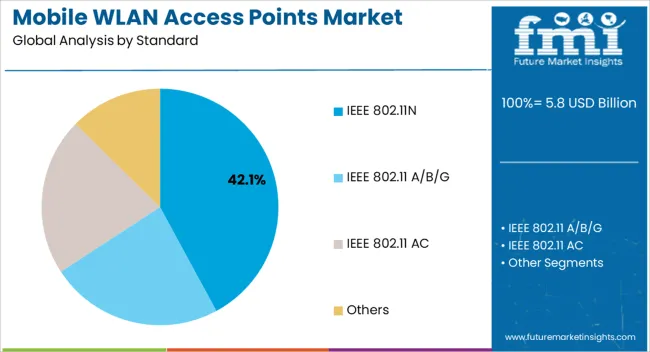
The IEEE 802.11n standard segment is projected to account for 42.1% of the mobile WLAN access points market revenue share in 2025, establishing it as the leading standard. Its strong position is being driven by the balance it offers between performance, cost-effectiveness, and wide compatibility with existing devices. The ability of IEEE 802.11n to deliver significantly higher data rates compared to previous standards has reinforced its adoption in diverse environments where reliability and speed are critical.
Its backward compatibility with earlier Wi-Fi generations ensures a smooth transition for enterprises and households, reducing the need for extensive infrastructure upgrades. The segment is also benefiting from its proven stability in supporting video streaming, voice-over-IP, and other bandwidth-intensive applications. Manufacturers have continued to enhance product designs based on this standard, integrating security protocols and power-efficient technologies that appeal to a wide customer base.
Its affordability compared to newer standards further supports sustained demand, particularly in cost-sensitive markets As a result, IEEE 802.11n remains a preferred option for organizations seeking a reliable, scalable, and well-established WLAN access point solution.
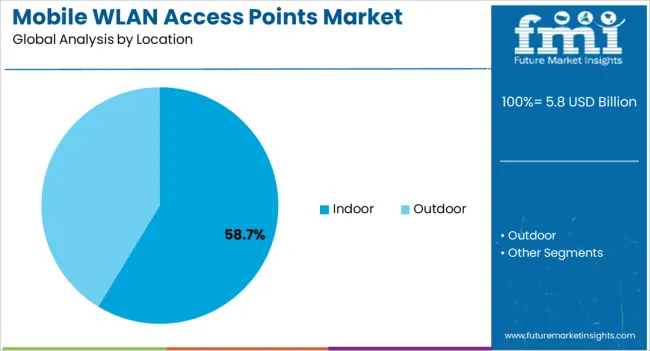
The indoor location segment is expected to capture 58.7% of the mobile WLAN access points market revenue share in 2025, making it the dominant deployment environment. This leadership is being reinforced by the growing demand for high-capacity and reliable connectivity within commercial complexes, educational institutions, healthcare facilities, and residential spaces. Indoor deployments benefit from the increasing reliance on mobile devices and cloud-based applications, where uninterrupted access to wireless networks is critical for both productivity and convenience.
The segment is also supported by the rapid growth of collaborative workspaces and e-learning platforms, which require consistent performance across large user groups. Advancements in access point design, including the integration of multiple-input multiple-output (MIMO) technology and improved signal processing, are enhancing coverage and capacity within enclosed environments.
Energy-efficient designs and compatibility with centralized management systems further encourage widespread adoption in enterprises As demand for smart building solutions and IoT-enabled applications grows, indoor access points are expected to remain the cornerstone of WLAN deployments, ensuring scalability and security while addressing evolving user requirements.
With growing number of smart devices over the years, number of connections to a particular network has risen. Access points are devices that serve as a transceiver between the wireless local area network (WLAN) and a wired network. Routers are mostly not capable to provide strong signal after certain distances because of various interference causing attenuation of signal, thus access points are then needed to strength the signal further.
With a specific network area, every access points are capable of serving multiple users. A user is automatically shifted to another access point as it moves beyond the range of a previous access point. Basically, wireless access points are designed to ensure a reasonably strong signal at any given time throughout a wireless network area. Furthermore, the number of access points to be installed depends on the number of users and the physical size of the network.
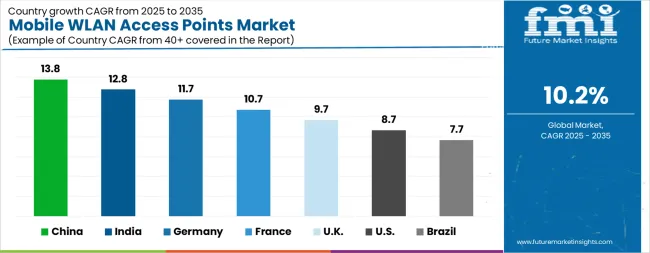
| Country | CAGR |
|---|---|
| China | 13.8% |
| India | 12.8% |
| Germany | 11.7% |
| France | 10.7% |
| UK | 9.7% |
| USA | 8.7% |
| Brazil | 7.7% |
The Mobile WLAN Access Points Market is expected to register a CAGR of 10.2% during the forecast period, exhibiting varied country level momentum. China leads with the highest CAGR of 13.8%, followed by India at 12.8%. Developed markets such as Germany, France, and the UK continue to expand steadily, while the USA is likely to grow at consistent rates. Brazil posts the lowest CAGR at 7.7%, yet still underscores a broadly positive trajectory for the global Mobile WLAN Access Points Market. In 2024, Germany held a dominant revenue in the Western Europe market and is expected to grow with a CAGR of 11.7%. The USA Mobile WLAN Access Points Market is estimated to be valued at USD 2.0 billion in 2025 and is anticipated to reach a valuation of USD 4.6 billion by 2035. Sales are projected to rise at a CAGR of 8.7% over the forecast period between 2025 and 2035. While Japan and South Korea markets are estimated to be valued at USD 298.1 million and USD 167.9 million respectively in 2025.
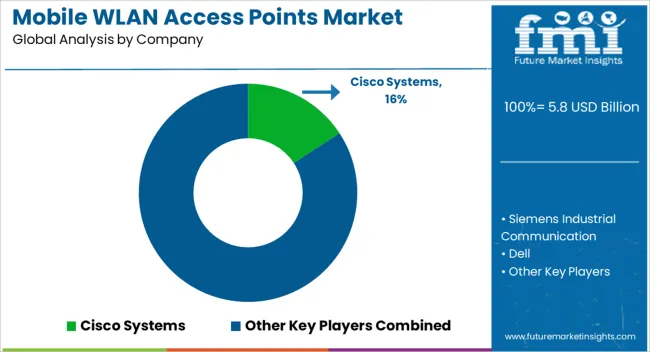
| Item | Value |
|---|---|
| Quantitative Units | USD 5.8 Billion |
| Standard | IEEE 802.11N, IEEE 802.11 A/B/G, IEEE 802.11 AC, and Others |
| Location | Indoor and Outdoor |
| Regions Covered | North America, Europe, Asia-Pacific, Latin America, Middle East & Africa |
| Country Covered | United States, Canada, Germany, France, United Kingdom, China, Japan, India, Brazil, South Africa |
| Key Companies Profiled | Cisco Systems, Siemens Industrial Communication, Dell, Hirschmann, ORing Industrial Networking, ACKSYS Communications & Systems, R. STAHL, Leviton, Extronics, LanPro, Pulse Engineering, Aktif Enerji, and CONTEC |
The global mobile WLAN access points market is estimated to be valued at USD 5.8 billion in 2025.
The market size for the mobile WLAN access points market is projected to reach USD 15.4 billion by 2035.
The mobile WLAN access points market is expected to grow at a 10.2% CAGR between 2025 and 2035.
The key product types in mobile WLAN access points market are ieee 802.11n, ieee 802.11 a/b/g, ieee 802.11 ac and others.
In terms of location, indoor segment to command 58.7% share in the mobile WLAN access points market in 2025.






Our Research Products

The "Full Research Suite" delivers actionable market intel, deep dives on markets or technologies, so clients act faster, cut risk, and unlock growth.

The Leaderboard benchmarks and ranks top vendors, classifying them as Established Leaders, Leading Challengers, or Disruptors & Challengers.

Locates where complements amplify value and substitutes erode it, forecasting net impact by horizon

We deliver granular, decision-grade intel: market sizing, 5-year forecasts, pricing, adoption, usage, revenue, and operational KPIs—plus competitor tracking, regulation, and value chains—across 60 countries broadly.

Spot the shifts before they hit your P&L. We track inflection points, adoption curves, pricing moves, and ecosystem plays to show where demand is heading, why it is changing, and what to do next across high-growth markets and disruptive tech

Real-time reads of user behavior. We track shifting priorities, perceptions of today’s and next-gen services, and provider experience, then pace how fast tech moves from trial to adoption, blending buyer, consumer, and channel inputs with social signals (#WhySwitch, #UX).

Partner with our analyst team to build a custom report designed around your business priorities. From analysing market trends to assessing competitors or crafting bespoke datasets, we tailor insights to your needs.
Supplier Intelligence
Discovery & Profiling
Capacity & Footprint
Performance & Risk
Compliance & Governance
Commercial Readiness
Who Supplies Whom
Scorecards & Shortlists
Playbooks & Docs
Category Intelligence
Definition & Scope
Demand & Use Cases
Cost Drivers
Market Structure
Supply Chain Map
Trade & Policy
Operating Norms
Deliverables
Buyer Intelligence
Account Basics
Spend & Scope
Procurement Model
Vendor Requirements
Terms & Policies
Entry Strategy
Pain Points & Triggers
Outputs
Pricing Analysis
Benchmarks
Trends
Should-Cost
Indexation
Landed Cost
Commercial Terms
Deliverables
Brand Analysis
Positioning & Value Prop
Share & Presence
Customer Evidence
Go-to-Market
Digital & Reputation
Compliance & Trust
KPIs & Gaps
Outputs
Full Research Suite comprises of:
Market outlook & trends analysis
Interviews & case studies
Strategic recommendations
Vendor profiles & capabilities analysis
5-year forecasts
8 regions and 60+ country-level data splits
Market segment data splits
12 months of continuous data updates
DELIVERED AS:
PDF EXCEL ONLINE
Mobile Phone Screen Underlayer Cushioning Material Market Size and Share Forecast Outlook 2025 to 2035
Mobile Application Store Market Size and Share Forecast Outlook 2025 to 2035
Mobile Money Market Forecast and Outlook 2025 to 2035
Mobile Application Testing Solution Market Size and Share Forecast Outlook 2025 to 2035
Mobile Cardiac Telemetry System Market Size and Share Forecast Outlook 2025 to 2035
Mobile Robots Market Size and Share Forecast Outlook 2025 to 2035
Mobile Crane Market Size and Share Forecast Outlook 2025 to 2035
Mobile Vascular Imaging Market Size and Share Forecast Outlook 2025 to 2035
Mobile Animal Inhalation Anesthesia Machine Market Size and Share Forecast Outlook 2025 to 2035
Mobile Unified Communications and Collaboration (UC&C) Solution Market Size and Share Forecast Outlook 2025 to 2035
Mobile Data Protection Market Size and Share Forecast Outlook 2025 to 2035
Mobile Medical Tablets Market Size and Share Forecast Outlook 2025 to 2035
Mobile Social Networks Market Size and Share Forecast Outlook 2025 to 2035
Mobile Printer Market Size and Share Forecast Outlook 2025 to 2035
Mobile Application Development Platform Market Size and Share Forecast Outlook 2025 to 2035
Mobile Threat Management Security Software Market Size and Share Forecast Outlook 2025 to 2035
Mobile Broadband Infrastructure Market Size and Share Forecast Outlook 2025 to 2035
Mobile Enterprise Application Development Platform Market Size and Share Forecast Outlook 2025 to 2035
Mobile Analytics Market Size and Share Forecast Outlook 2025 to 2035
Mobile Robotics Software Market Size and Share Forecast Outlook 2025 to 2035

Thank you!
You will receive an email from our Business Development Manager. Please be sure to check your SPAM/JUNK folder too.
Chat With
MaRIA